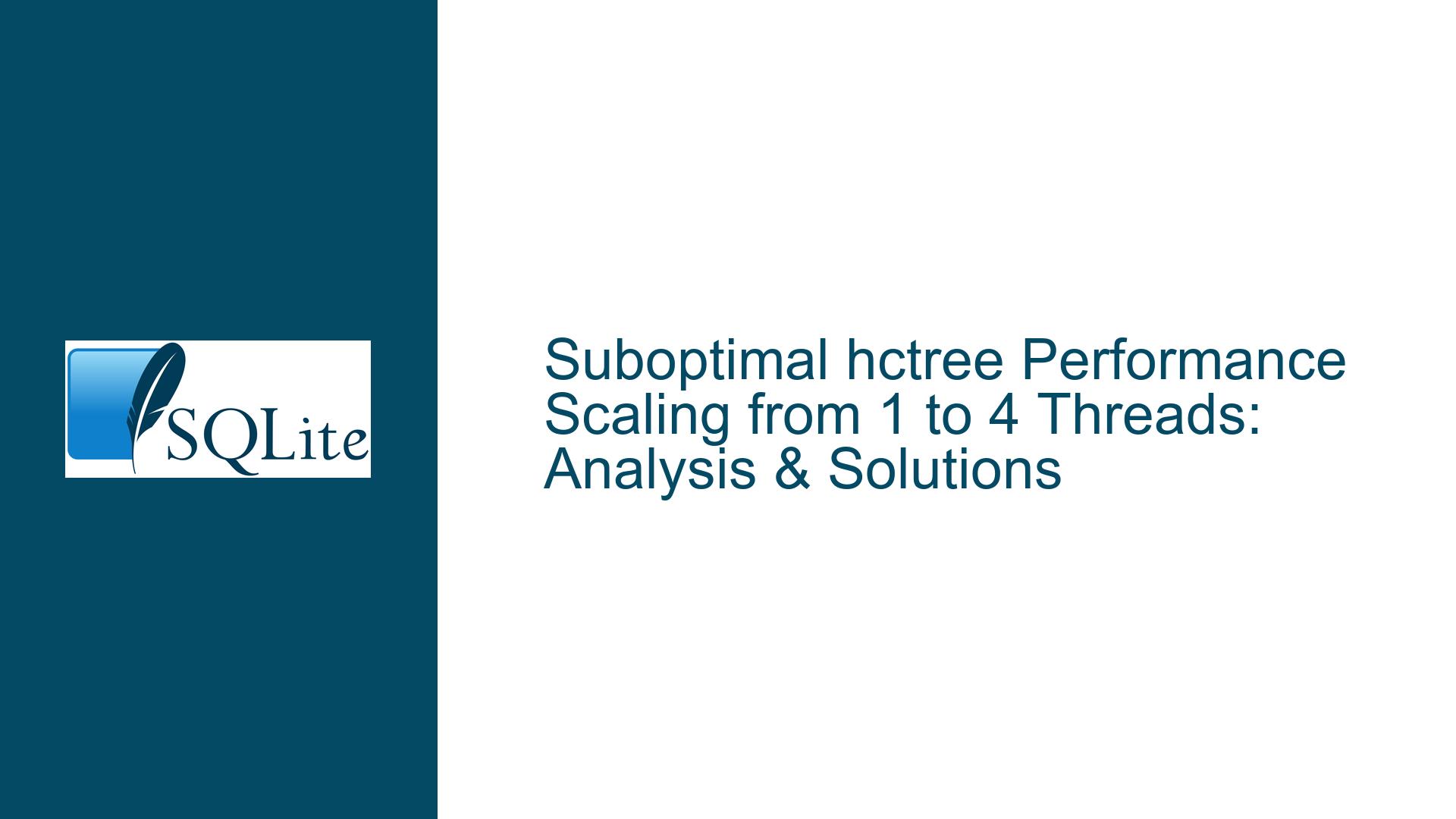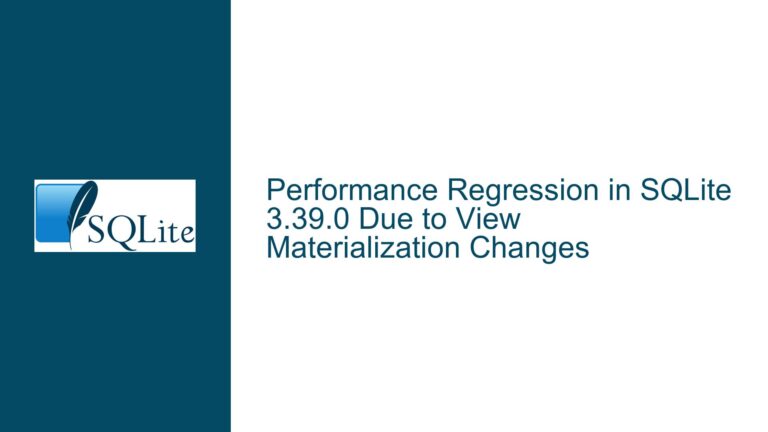Suboptimal hctree Performance Scaling from 1 to 4 Threads: Analysis & Solutions
Observed Performance Anomaly in Multithreaded hctree Benchmarks
The core issue revolves around unexpected performance scaling characteristics observed during multithreaded benchmarks of SQLite’s hctree implementation. When increasing the number of worker threads from 1 to 4, throughput improvements fall short of theoretical expectations. While linear scaling is rarely achievable due to inherent concurrency overheads, the reported sublinear gains (e.g., 1.5x-2x improvement instead of 3x-4x) suggest systemic bottlenecks. This anomaly manifests specifically in CPU-bound workloads where thread parallelism is expected to reduce task completion time proportionally. The problem becomes acute in low-core-count scenarios (1-4 threads), where modern CPU architectures typically exhibit strong scaling behavior. Key metrics include total operations per second, thread wait states, and CPU utilization patterns across cores.
A critical observation is the discrepancy between thread count increases and effective workload distribution. In ideal scenarios, quadrupling threads should yield near-quadruple throughput for embarrassingly parallel tasks. However, hctree’s architecture introduces shared resources – particularly the database handle, page cache, and I/O subsystems – that create contention points. The benchmark results suggest that these contention points disproportionately affect performance at low thread counts, contrary to conventional wisdom where scaling issues typically emerge at higher core counts (8+ threads). This implies a unique interaction between hctree’s concurrency model and modern CPU power management features like turbo boost.
The problem domain intersects three layers: hardware behavior (CPU frequency scaling), OS thread scheduling, and hctree’s internal synchronization mechanisms. Turbo boost – Intel’s dynamic frequency scaling technology – allows single-core clock speeds to exceed base frequencies when thermal headroom exists. As more cores activate, available turbo headroom decreases, creating a non-linear relationship between active cores and effective per-core performance. This phenomenon directly impacts benchmarks measuring scaling efficiency across low thread counts. Concurrently, SQLite’s default threading mode (serialized) imposes coarse-grained locking that may negate fine-grained parallelism benefits unless explicitly configured for multithreaded operation.
Hardware and Configuration Factors Impacting Thread Scaling Efficiency
Turbo boost dynamics represent a primary suspect due to their direct influence on per-core instruction throughput. Modern CPUs operate under thermal design power (TDP) constraints that enforce inverse relationships between active core count and maximum achievable clock speeds. For example, a CPU with a base frequency of 2.5 GHz might boost to 4.5 GHz when one core is active but drop to 3.2 GHz when all four cores are utilized. This frequency decay curve directly impacts benchmarks expecting linear scaling – a 4-thread workload might only deliver 3.2/4.5 = 71% of per-core performance compared to the single-threaded case. Actual throughput would then scale as 4 * 0.71 = 2.84x, not 4x, even before accounting for software overheads.
Thermal throttling introduces additional variability. Sustained multithreaded workloads generate heat that may force the CPU to reduce clock speeds below even base frequencies if cooling solutions are inadequate. This creates time-dependent performance degradation where initial benchmark phases show strong scaling that deteriorates as thermal limits are reached. Monitoring tools must therefore capture both instantaneous frequency and temperature trends throughout the entire benchmark duration rather than relying on spot measurements.
At the software layer, SQLite’s threading modes critically influence scaling potential. The default serialized mode forces all database connections to share a single mutex, effectively serializing access across threads. While the multithreaded mode allows separate connections to operate concurrently, hctree’s internal page cache and write-ahead log (WAL) management may still create contention. For example, concurrent writers must coordinate WAL index updates, and page cache evictions require synchronization. If the benchmark employs a shared database connection across threads (instead of separate connections), locking contention will dominate performance characteristics regardless of CPU capabilities.
Memory subsystem limitations further complicate analysis. Multi-core workloads stress memory bandwidth and cache coherency protocols. Each additional thread increases last-level cache (LLC) miss rates and DRAM bus contention. While these factors typically manifest at higher thread counts, memory-intensive workloads (large page caches, frequent B-tree traversals) may exhibit early scaling collapse. hctree’s append-heavy write patterns could exacerbate this by generating cache-unfriendly access patterns across multiple threads.
Systematic Diagnosis and Mitigation Strategies for Concurrency-Related Throughput Loss
Phase 1: Hardware Profiling
Begin by establishing baseline CPU behavior during benchmark execution. On Linux systems, the turbostat tool provides real-time monitoring of core frequencies, C-states, and thermal conditions. Execute the benchmark with varying thread counts while logging:
turbostat --show Core,CPU,Busy%,Bzy_MHz,PkgTmp,PkgWatt --interval 5 -S
Compare per-core busy percentages (Bzy_MHz) across thread configurations. A healthy scaling scenario shows stable frequencies near turbo limits for single-threaded runs, with gradual frequency decline as threads increase. A pathological pattern exhibits abrupt frequency drops even at low thread counts, indicating thermal/power constraints. For Windows, use Intel Power Gadget or ThrottleStop to track frequency/temperature.
Concurrently monitor memory bandwidth usage via perf stat -d (Linux) or VTune Profiler’s memory analysis suite. High LLC-miss rates (>5% of total accesses) suggest memory-bound workloads where adding threads provides diminishing returns. If memory bandwidth saturation occurs at 4 threads, scaling improvements require algorithmic changes (reducing working set size, improving cache locality) rather than concurrency tuning.
Phase 2: SQLite Configuration Audit
Verify that the benchmark employs SQLite’s multithreaded mode by checking sqlite3_config(SQLITE_CONFIG_MULTITHREAD) during initialization. In serialized mode, all database operations serialize through a single lock, rendering additional threads useless for CPU-bound workloads. Confirm connection handling: each thread should utilize a separate sqlite3* handle with SQLITE_OPEN_NOMUTEX or SQLITE_OPEN_FULLMUTEX as appropriate. Shared page cache configurations (SQLITE_CONFIG_PAGECACHE) may require tuning – oversized caches can trigger excessive mutex contention during page lookups.
Analyze WAL configuration parameters:
wal_autocheckpoint: Frequent checkpoints force WAL file truncation, which acquires exclusive lockswal_sync_method:FULL(fsync) vs.NORMAL(fdatasync) impacts I/O wait times during concurrent writesjournal_size_limit: Oversized WAL files increase fsync latency during checkpointing
Experiment with increasing the WAL auto-checkpoint threshold and using PRAGMA synchronous=NORMAL to reduce I/O bottlenecks. However, balance reliability concerns against benchmark purity.
Phase 3: Application-Level Contention Reduction
If hardware and SQLite configuration checks pass, focus on hctree-specific optimizations. The hierarchical counting tree structure relies on atomic operations for node updates. Profile the benchmark using perf record -g -e cycles:pp to identify hotspots in hctree’s insertion/search paths. Look for excessive __sync_fetch_and_add usage or long critical sections guarded by sqlite3_mutex_enter().
Consider sharding the database file if the workload allows it. Splitting data into multiple databases (e.g., by key range) enables true parallelism with separate WAL files and page caches. This avoids global lock contention at the expense of increased application complexity.
For read-heavy workloads, leverage SQLite’s shared cache mode cautiously. While SQLITE_OPEN_SHAREDCACHE allows connections to share a common page cache, it introduces finer-grained locking that may improve read scaling. However, write operations still require exclusive access, so evaluate read/write ratios before implementation.
Phase 4: Thermal and Power Management Tuning
If CPU frequency throttling is identified as the primary bottleneck, reconfigure system power settings. On Linux, switch to the performance governor to maximize core frequencies:
cpupower frequency-set -g performance
Disable turbo boost entirely for consistent frequency baselines:
echo 1 > /sys/devices/system/cpu/intel_pstate/no_turbo
Monitor temperature trends using sensors or ipmitool. If thermal throttling persists despite cooling improvements, consider underclocking the CPU to maintain stable frequencies under multithreaded loads. While counterintuitive, a stable 3.0 GHz across all cores may outperform fluctuating 2.5-4.0 GHz frequencies that trigger frequent throttling.
Phase 5: Alternative Concurrency Models
When all else fails, reevaluate the threading architecture. Instead of parallelizing individual operations across threads, batch processing with producer-consumer queues can amortize synchronization costs. For example, dedicate one thread to SQLite operations while worker threads prepare transactions in memory. This serializes database access but eliminates lock contention, potentially outperforming naive multithreading.
Explore SQLite’s virtual table interface to implement custom concurrency-aware storage engines. By bypassing SQLite’s native B-tree/hctree layers, developers can introduce partition-level locking or lock-free data structures tailored to specific workload patterns. This nuclear option requires deep expertise but offers ultimate flexibility for extreme scaling scenarios.
Final Recommendations for Reproducible Benchmarking
To isolate hctree’s scaling characteristics from environmental variables:
- Conduct benchmarks on a thermally stable system – disable turbo boost, use liquid cooling, and maintain ambient temperature
- Lock CPU frequencies to fixed values using
cpupower frequency-set -d X -u X - Employ
SCHED_FIFOreal-time scheduling to minimize OS-induced jitter - Preallocate database files to eliminate filesystem fragmentation effects
- Run multiple benchmark iterations, discarding initial warm-up results to account for filesystem cache population
Through systematic hardware profiling, SQLite configuration tuning, and algorithmic optimizations, developers can mitigate sublinear thread scaling in hctree workloads. The key insight is recognizing that modern CPU frequency management often obscures true software scalability – only by controlling for hardware variability can intrinsic concurrency limitations be accurately diagnosed and addressed.






